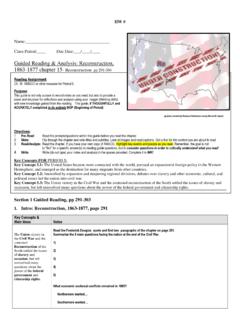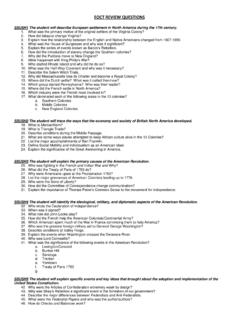Transcription of APUSH KEY CONCEPTS - Mrs. Thompson APUSH Blog
1 APUSH KEY CONCEPTS . Period 5: 1844-1877. Key concept : The United States became more connected with the world, pursued an expansionist foreign policy in the Western Hemisphere, and emerged as the destination for many migrants from other countries. I. Popular enthusiasm for expansion, bolstered by economic and security interests, resulted in the acquisition of new territories, substantial migration westward, and new overseas initiatives. Related Thematic Learning Objectives (Focus on Exam Questions) NAT- : Analyze how ideas about national identity changed in response to involvement in international conflicts and the growth of the United States. MIG- : Analyze causes of internal migration and patterns of settlement in what would become the United States, and explain how migration has affected American life.
2 GEO- : Explain how geographic and environmental factors shaped the development of various communities, and analyze how competition for and debates over natural resources have affected both interactions among different groups and the development of government policies. WOR- : Explain how cultural interaction, cooperation, competition, and conflict between empires, nations, and peoples influenced political, economic, and social developments in North America. have WOR- : Analyze the reasons for, and results of, diplomatic, economic, and military initiatives in North America and overseas. A. The desire for access to natural and mineral resources and the hope of many settlers for economic opportunities or religious refuge led to an increased migration to and settlement in the West.
3 B. Advocates of annexing western lands argued that Manifest Destiny and the superiority of American institutions compelled the United States to expand its borders westward to the Pacific Ocean. C. The added large territories in the West through victory in the Mexican American War and diplomatic negotiations, raising questions about the status of slavery, American Indians, and Mexicans in the newly acquired lands. D. Westward migration was boosted during and after the Civil War by the passage of new legislation promoting Western transportation and economic development. E. interest in expanding trade led to economic, diplomatic, and cultural initiatives to create more ties with Asia. II. In the 1840s and 1850s, Americans continued to debate questions about rights and citizenship for various groups of inhabitants.
4 Related Thematic Learning Objectives (Focus on Exam Questions) NAT- : Analyze relationships among different regional, social, ethnic, and racial groups, and explain how these groups' experiences have related to national identity. CUL- : Explain how different group identities, including racial, ethnic, class, and regional identities, have emerged and changed over time. MIG- : Explain the causes of m igration to colonial North America and, later, the United States, and analyze immigration's effects on society. A. Substantial numbers of international migrants continued to arrive in the United States from Europe and Asia, mainly from Ireland and Germany, often settling in ethnic communities where they could preserve elements of their languages and customs. B. A strongly anti- Catholic nativist movement arose that was aimed at limiting new immigrants' political power and cultural influence.
5 C. government interaction and conflict with Mexican Americans and American Indians increased in regions newly taken from American Indians and Mexico, altering these groups' economic self- sufficiency and cultures. Key concept : Intensified by expansion and deepening regional divisions, debates over slavery and other economic, cultural, and political issues led the nation into civil war. I. Ideological and economic differences over slavery produced an array of diverging responses from Americans in the North and the South. Related Thematic Learning Objectives (Focus on Exam Questions) NAT- : Explain how ideas about democracy, freedom, and individualism found expression in the development of cultural values, political institutions, and American identity. POL- : Explain how popular movements, reform efforts, and activist groups have sought to change American society and institutions.
6 WXT- : Explain how different labor systems developed in North America and the United States, and explain their effects on workers' lives and society. CUL- : Explain how artistic, philosophical, and scientific ideas have developed and shaped society and institutions. A. The North's expanding manufacturing economy relied on free labor in contrast to the Southern economy's dependence on slave labor. Some Northerners did not object to slavery on principle but claimed that slavery would undermine the free labor market. As a result, a free- soil movement arose that portrayed the expansion of slavery as incompatible with free labor. B. African American and white abolitionists, although a minority in the North, mounted a highly visible campaign against slavery, presenting moral arguments against the institution, assisting slaves' escapes, and sometimes expressing a willingness to use violence to achieve their goals.
7 C. Defenders of slavery based their arguments on racial doctrines, the view that slavery was a positive social good, and the belief that slavery and states' rights were protected by the Constitution. II. Debates over slavery came to dominate political discussion in the 1850s, culminating in the bitter election of 1860 and the secession of Southern states. Related Thematic Learning Objectives (Focus on Exam Questions) NAT- : Explain how interpretations of the Constitution and debates over rights, liberties, and definitions of citizenship have affected American values, politics, and society. POL- : Explain how and why political ideas, beliefs, institutions, party systems, and alignments have developed and changed. A. The Mexican Cession led to heated controversies over whether to allow slavery in the newly acquired territories.
8 B. The courts and national leaders made a variety of attempts to resolve the issue of slavery in the territories, including the Compromise of 1850, the Kansas Nebraska Act, and the Dred Scott decision, but these ultimately failed to reduce conflict. C. The Second Party System ended when the issues of slavery and anti- immigrant nativism weakened loyalties to the two major parties and fostered the emergence of sectional parties, most notably the Republican Party in the North. D. Abraham Lincoln's victory on the Republicans' free- soil platform in the presidential election of 1860 was accomplished without any Southern electoral votes. After a series of contested debates about secession, most slave states voted to secede from the Union, precipitating the Civil War.
9 Key concept : The Union victory in the Civil War and the contested reconstruction of the South settled the issues of slavery and secession, but left unresolved many questions about the power of the federal government and citizenship rights. I. The North's greater manpower and industrial resources, the leadership of Abraham Lincoln and others, and the decision to emancipate slaves eventually led to the Union military victory over the Confederacy in the devastating Civil War. Related Thematic Learning Objectives (Focus on Exam Questions) NAT- : Explain how ideas about democracy, freedom, and individualism found expression in the development of cultural values, political institutions, and American identity. WOR- : Analyze the reasons for, and results of, diplomatic, economic, and military initiatives in North America and overseas.
10 A. Both the Union and the Confederacy mobilized their economies and societies to wage the war even while facing considerable home front opposition. B. Lincoln and most Union supporters began the Civil War to preserve the Union, but Lincoln's decision to issue the Emancipation Proclamation reframed the purpose of the war and helped prevent the Confederacy from gaining full diplomatic support from European powers. Many African Americans fled southern plantations and enlisted in the Union Army, helping to undermine the Confederacy. C. Lincoln sought to reunify the country and used speeches such as the Gettysburg Address to portray the struggle against slavery as the fulfillment of America's founding democratic ideals. D. Although the Confederacy showed military initiative and daring early in the war, the Union ultimately succeeded due to improvements in leadership and strategy, key victories, greater resources, and the wartime destruction of the South's infrastructure.




